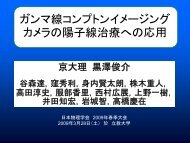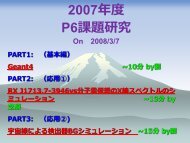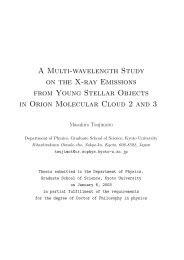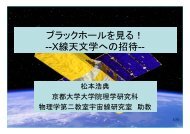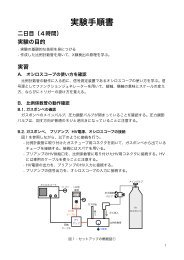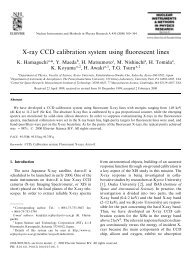X-ray Study of Low-mass Young Stellar Objects in the ρ Ophiuchi ...
X-ray Study of Low-mass Young Stellar Objects in the ρ Ophiuchi ...
X-ray Study of Low-mass Young Stellar Objects in the ρ Ophiuchi ...
Create successful ePaper yourself
Turn your PDF publications into a flip-book with our unique Google optimized e-Paper software.
6.5. NEW YSO CANDIDATES – A-29, A-31, AND BF-36 87embedded star scenario.Consider<strong>in</strong>g that N H <strong>of</strong> BF-36 is ra<strong>the</strong>r typical <strong>of</strong> those <strong>of</strong> class I sources (see Figure 7.3), itis located at ra<strong>the</strong>r <strong>of</strong>f-center position, and a class II source GY238 (BF-33) is closer to <strong>the</strong> center<strong>of</strong> SMM J16272−2430, BF-36 would be a more evolved star than <strong>the</strong> class 0 stage, possibly classI or II. Assum<strong>in</strong>g <strong>the</strong> average ratio <strong>of</strong> < L X >/L bol to be 10 −4.0 <strong>in</strong> <strong>the</strong> quiescent phase for YSOs(§7.4.2) and us<strong>in</strong>g N H <strong>of</strong> 9×10 22 cm −2 , L bol and A V <strong>of</strong> BF-36 are expected to be ∼0.8 L ⊙ and∼60 mag (§7.4.1). These are above <strong>the</strong> current detection limit; some NIR-detected sources havenearly <strong>the</strong> same values (see Figure 7.1). One possibility <strong>of</strong> no NIR counterpart is that BF-36 is aYSO with very active X-<strong>ray</strong>s. Assum<strong>in</strong>g < L X >/L bol <strong>of</strong> ≈10 −3.5 , we <strong>the</strong>n expect L bol <strong>of</strong> 0.08 L ⊙ ,which is below or near <strong>the</strong> current detection limit (Figure 7.1).6.5.5 Ionization effect to circumstellar materialsThe flare lum<strong>in</strong>osity and duty ratio <strong>of</strong> A-29, A-31, BF-36 are ∼10 30 ergs s −1 and roughly one per100 ks, respectively. Due to <strong>the</strong> large absorption, a significant fraction <strong>of</strong> X-<strong>ray</strong> energy is supplied<strong>in</strong>to circumstellar materials. Us<strong>in</strong>g <strong>the</strong> parameters <strong>in</strong> Table 6.6, we estimate <strong>the</strong> X-<strong>ray</strong> ionizationrate (ζ X : Lorenzani & Palla 2001); <strong>the</strong> fraction <strong>of</strong> protons to be photo-ionized per unit time, whichis def<strong>in</strong>ed asζ X = 1.7 < L X > ˜σ4πr 2 ∆ɛ∫Jν e −n H˜σr( νν X) −n dν∫Jν dν[s −1 ], (6.3)where σ(E) = ˜σ(E/1keV) −n is <strong>the</strong> total photoelectric cross section with n = 2.51 and ˜σ =2.16×10 −22 cm 2 , ∆E (≡ 35 eV) is <strong>the</strong> mean energy to make an ion-electron pair with cosmicabundance, n H is <strong>the</strong> proton <strong>mass</strong>, J ν is monochromatic X-<strong>ray</strong> flux (ergs s −1 Hz −1 ), and r is <strong>the</strong>distance from <strong>the</strong> X-<strong>ray</strong> source. We assume n H <strong>of</strong> A-31 and BF-36 to be 1.5×10 8 and 1.3×10 6 cm −3 ,follow<strong>in</strong>g Motte et al. (1998) and Kamazaki et al. (2001). S<strong>in</strong>ce N H <strong>of</strong> A-29 is about a half <strong>of</strong> A-31,n H is assumed to be 7.5×10 7 cm −3 for A-29. Then we obta<strong>in</strong> <strong>the</strong> “ionization radius”, <strong>in</strong> which ζ Xexceeds that <strong>of</strong> cosmic <strong>ray</strong>s, to be ∼10 2.5 , 10 2.4 , and 10 3.1 AU, respectively (Figure 6.22). Thesesizes are significantly smaller than <strong>the</strong> “parent” core size <strong>of</strong> typically 10 3.8 AU, hence have no largeimpact <strong>in</strong> global structure. In a smaller scale <strong>of</strong> close vic<strong>in</strong>ity <strong>of</strong> <strong>the</strong> YSOs (KSHK-A, for example),however, <strong>the</strong> X-<strong>ray</strong> ionization may still have significant effect on <strong>the</strong> circumstellar materials. S<strong>in</strong>ce<strong>the</strong> <strong>mass</strong> accretion is thought to be coupled to <strong>the</strong> magnetic field (Feigelson & Montmerle, 1999),our result may put significant <strong>in</strong>fluence on <strong>the</strong> growth <strong>of</strong> YSOs.






